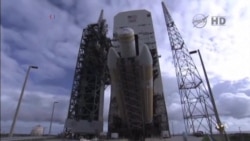ໝົດທຸກລະບົບ “ຕຽມພ້ອມ” ສຳລັບການສົ່ງຍານອະວະກາດ
ລຳໃໝ່ຂອງອົງການນາຊາສະຫະລັດໃນວັນພະຫັດມື້ນີ້ ຊຶ່ງໃນ
ຂັ້ນຕໍ່ໄປນັ້ນຈະສົ່ງພວກນັກອະວະກາດໄປນອກຂອບວົງໂຄ
ຈອນຂອງໂລກໃນທົດສະວັດໜ້າ.
ການທົດລອງຖ້ຽວບິນຍານອະວະກາດ Orion ກຳນົດຈະເລີ້ມ
ຂຶ້ນໃນເຊົ້າວັນພະຫັດມື້ນີ້ ເວລາ 7 ໂມງ 05 ນາທີຕອນເຊົ້າ
ຕາມເວລາໃນທ້ອງຖິ່ນ ກົງກັນກັບເວລາ 12:05 ຕອນບ່າຍ
ຕາມເວລາມາດຕະຖານສາກົນ ເວລາຍານອະວະການລຳນີ້
ທະຍານຂຶ້ນຈາກບໍລິເວນສົ່ງຍານທີ່ Cape Canaveral ທີ່
ລັດຟລໍຣິດາ ໃນພາກຕາເວັນອອກສຽງໃຕ້ຂອງສະຫະລັດ.
ຍານອະວະກາດທີ່ບໍ່ຄົນຂັບຂີ່ໄປນຳລຳນີ້ ກຳນົດຈະທຳການໂຄຈອນອ້ອມໂລກ 2 ຮອບ
ໃນຄວາມສູງເກືອບ 5800 ຫຼັກກິໂລແມັດ ຊຶ່ງເປັນໄລຍະທີ່ສູງກວ່າ 14 ເທົ່າຂອງສະຖານີອະວະກາດລະຫວ່າງຊາດ.
ຫຼັງຈາກບິນຂຶ້ນສູ່ອະວະກາດເປັນເວລາ 4 ຊົ່ວໂມງແລ້ວ ຍານ Orion ຈະກັບຄືນເຂົ້າສູ່
ວົງໂຄຈອນຂອງໂລກໃນຄວາມໄວ 32 ພັນຫຼັກກິໂລແມັດຕໍ່ຊົ່ວໂມງ ກ່ອນຈະລົງສູ່ມະຫາສະມຸດປາຊີຟິກ ນອກແຄມຝັ່ງ ເມືອງ Baja ລັດ California ນັ້ນ.
All systems are "go" for Thursday's launch of the U.S. space agency NASA's new spacecraft that will eventually send astronauts beyond Earth's orbit beginning in the next decade.
The test flight of the Orion capsule is scheduled to begin Thursday morning ((at 7:05 a.m./1205 p.m. GMT)) when it lifts off into space from the Cape Canaveral launch complex in ((the southeastern state of)) Florida.The unmanned spacecraft is scheduled make two orbits of the Earth at an altitude of nearly 5,800 kilometers -- more than 14 times higher than the International Space Station.
After its four hour flight, Orion will re-enter the Earth at a speed of 32,000 kilometers an hour, before splashing down in the Pacific Ocean off the coast of Baja California.
Officials say there is a 70 percent chance of good weather by launch time.
Dr. Ellen Ochoa, NASA's Johnson Space Center Director:
"This is really an exciting and important mission for us. We will in the future be putting our astronauts on board and we are testing some of the highest risks."
NASA says the first manned mission aboard Orion will not happen until at least 2021.Once it is fully operational, Orion will carry anywhere from four to six astronauts on deep space missions to the moon, an asteroid and eventually Mars.
The space agency is developing a new rocket, dubbed the Space Launch System, that will be powerful enough to send Orion beyond Earth's gravity.
Since the last space shuttle flight in 2011, U.S. astronauts have been transported to the ISS aboard Russia's Soyuz capsule.NASA has awarded contracts to two private companies, Boeing and Space X, tobegin ferrying astronauts to the orbital outpost beginning in 2017.






